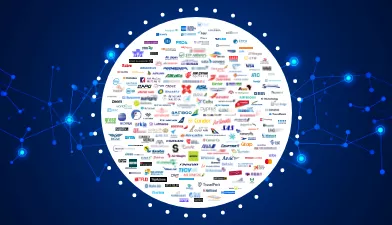On demand | Elevate 2022
Is your airline making the most of your membership?
SOLUTION BREAKOUT • COMMUNITY PARTICIPATION
So, you’re already part of our Community Participation program, but are you utilizing it to level up your game in the best way possible?
Come find out how airlines can use tools included in Community Participation to keep up with competitive markets, optimize merchandising content, and be involved in future developments of ATPCO products and industry solutions.
Zachary: My name is Zachary Wynne. I’m a Partner Success Director out of our London office. Mostly I look after our airlines in the Middle East, Africa, a little bit of eastern Europe… all over the place. Been at ATPCO for a very long time at this point. Doing lots of different things that'll all be in the ideas of how we can really partner with our airlines and our sales channels to make all the things that we have been talking about over the next two days happen.
I forgot our disclaimer! Disclaimer: The purpose of this meeting is to discuss the coding, processing, and standardization of airfare-related data by the airline industry to make the distribution an interpretation of airfare-related data more accurate, automated, and efficient. Participants must conduct themselves in a manner consistent with this meeting’s industry wide pro-competitive mission.
Because some, if not all, participants represent companies that compete with one another, we must not engage in conduct that could be perceived as a violation of the antitrust laws or the competition laws around the world.
Accordingly, this meeting will not discuss or take action regarding any fare, rule, or fee, nor will it discuss or take action on remuneration levels of any intermediaries engaged in the sale of passenger air transportation. This meeting also has no authority to discuss or reach agreement on the allocation of markets, the division or sharing of traffic or revenues, or the number of flights or capacity to be offered in the market.
Discussions regarding such matters, or concerning any other competitively sensitive topics, either on the floor off, are strictly prohibited. Discussing or reaching any agreement relate to these topics could expose meeting participants to liability under the US antitrust laws or under the competition laws of other jurisdictions around the world.
Further, so the content of this meeting is not misinterpreted, ATPCO requests that participants refrain from any communications concerning that content over social media or other public platforms.
Wow! That’s done. It’s not my first time having to say this. This is so much more fun than over Zoom. Zoom just gets really awkward. This is much nicer.
In working with airlines all over the world, one thing that we see is at these conferences and other industry events… it's a lot of information. It's a lot of envisioning. What are we doing in the future? How are we getting dynamic offers to scale? How do we grow and succeed from the 10 to 20% we have today? It’s a lot.
So, more specifically, where do you get started as an airline? This is what this session is all about.
It’s to say, let’s take all of those kind of the concepts that we've discussed, we've heard about so far from the speakers, what can you take back the organization? Or for yourselves, what would your partner airlines or other folks as well in the industry ecosystem.
So, we need structure with our partnership with airlines, which we've done quite an overhaul of the past few years. It's really made it more about how do we enable these things to happen? So, it used to be okay…
When you go with ATPCO, that allows you to do so many things. Primarily, GDS distribution. That was a thought-on use case. That hasn't been the case in the number of years. We've really expanded to do a lot more and really to enable what we talked about today.
So we talk about, what do you do to get going? You start. I think the message on stage, especially today that we heard in the very first session, Richard Clarke, our colleagues from McKinsey, as well as our CEO Alex Zoghlin, said we need to start. Doesn't matter what it is… just do the next thing. We need to get going and make it happen.
So, starting with retailing. Retailing, of course Routehappy is one of the products. I worked on that product for number of years and had a lot of fantastic stories that we say is that our community of almost 500 airlines, everybody can start retailing today. Starting with airline's branded fares and getting that information through many places as possible to talk about that.
Analysis can be done today within... [inaudible]
In addition, there's a lot of other things that just exist that all of our Community Participation members have access to. And then dynamic pricing… starting and transforming. It's a long journey. A lot of systems and ideas involved. How do we get going? What are the first steps you can take to make that a reality? What are airlines our doing? Whatever we found in the work that we've done with the community, almost 500 airlines, over the last few years to really get going.
So, that’s the call-to-action, thing that really would like you all to take away from this… is let's start. Let's start doing this today, because we don't want to be left behind as an industry. We don't want to be left behind by other organizations. We really want to make the most of the partnership that we have.
Fare attributes are the foundation, and, of course, we have visual displays powered by Routehappy, but underneath, and what is powering the capital as well as many other sales channels around the world, are fare attribute. Note we’re not saying branded fares. Now that is that is the name of the system within ATPCO where the data all lives. More importantly, is how do we express that in a way that a customer can see?
So, what we did when we acquired Routehappy is to take that technology that will look across the different systems within ATPCO, especially with branded fares, and translate that data into something a passenger can understand. In up to 28 languages by the way. So we haven't displayed in English here, but if I were pressing the display in German or in Arabic or in traditional Chinese, it would show up here as well, automatically reflecting exactly what is created within ATPCO.
This example is from Kayak, but I can pick any other channels, and GDS, and meta. We have OTAs right now really to start driving people to the different places they can buy your products. And this is so important because this is such a basic thing about retailing, but particularly when we look outside of the markets that you are able to serve or that you're well known and other places...
I know a lot of airline products that work in this business and I've been able to travel around the world, but it's really hard to see that other places. How do you tell people, one part of our value proposition is seating? Southwest Airlines. Because that is a key value prop, is a key driver. Or is it the luggage? What is it that drives people to do this?
Putting that information into ATPCO is what we do. That is the core of our business and that's what… [inaudible]
If you put this information out there and sell it… it can be in a branded or a fare family type display like we have here. But even if it's not or it's just a dynamically created bundle, or there is no brand, the same attributes get pulled in and are displayed in that way. We're able to give a couple of different reasons this is done here.
This example, I really like this to get the visuals, but then more importantly, you can have all these rules and allowances. That's coming off the reported ATPCO data in and that is expressed.
[inaudible]
I love what Expedia has done now, which we’ve touched on this a little bit, where they have attribute-based shopping. That seat choice included, that seat data comes from ATPCO branded fares. Directly, if that data is not good, it will not show up and I have my partner airlines have said, “Why is Expedia showing these very expensive things when I click it?”
[inaudible]
Or more importantly, you haven't opened your branded fare program.
[inaudible]
The other example I like on this slide is American Airlines and their agency bundles. So, new interesting offers that are unique to the distribution channel.
For us, as the industry neutral provider, our job is to just get the best data out there and make it accurate to describe your product.
[inaudible]
But a really important point is to ensure that those brand programs are open. I say this because when this was invented a number of years ago, it was really done by system to system implementations. You’d would have one seller who wanted to get their actual information from the airline, would send it to that seller, and to that seller, and do all this to attract all of that in the ATPCO data structures. Now, passengers just come from everywhere. It's important to have an ability to showcase your products at a high level so people know where to go and see it.
And that thing is really, really important and we’ve done that work, so. You know, couple different airlines this year we will be able to unlock that, opening them up so that when someone is searching on Google, which is one out of every 10 searches for air travel starts with Google, I think this is perfect. They type it in, there it is.
[inaudible]
They want to go to Skyscanner, or their favorite meta star. Boom. It's the correct attributes that are being used to showcase or OTA or in travel agent to searching for something in their desktop. All of this stuff is important. It's important to have it open so that everyone can access this.
Any questions so far?
[inaudible]
Some of the baggage wants, more baggage, but the other options, especially seats, very important. And again the indicator on this is just whether or not there's purchasing or it's free or not included. Then you drive down and of course there's the ancillaries that go along with it, which is too much to display at initial time of flight shopping, but of course there is that robust set of data in the background.
And there's now feedback.
The automation pricing decisions, which is that we give every airline that works with ATPCO a baseline of the tool to look at what's going on in the marketplace because of the market here. If you’ve heard of ATPCO Architect, very large system, very robust system. This is actually part of that whole journey in terms of fare management.
How do you take information that is out there in the marketplace so you can make better decisions? How do you clear what's going on with your competition? Or how do you look at your own data, how do you look at your own benchmarks? What products do I have on the shelf right now when you're doing inventory?
It's amazing how many airlines actually don’t do that and look at their own data and say okay what do I have out there? Why? What's going on? And many years working with airlines on site, they would tell me, yeah, we spend a lot of time chasing our own problems or oh we forgot we had that fare out there in the market selling. This is a great way to audit.
So, we include all pieces of the fare that are necessary. So, not just the base fare, but the surcharge, the carrier-imposed fee, and all the taxes as well. So, we can really create that whole picture of yourselves and any other public data from any of your competitors available in the single place and get included with certain number of queries per month as part of the expansion.
Audience member: Is it refreshed every day?
Zachary: Every time we send changes to the market, we send it from one of our servers to another. So, it should always reflect. It's actually reflects faster than GDSs. No, we don’t… never mind. GDSs, which is really, well of course they're dealing with large scale volumes they get; we're sending it from one server to one cell. So yeah, it's always the most accurate picture of the market and actually several airlines that are using it as that… as a check in their process to say, okay, I think I've done everything right. I have the offer where I need to be. Let me just want to run it again and see, okay, let's move on to the next thing.
And of course, dynamic pricing. Massive, massive topic. So much that can be done. Many great providers in this space. You've heard from some of them over the last couple of days. You’ve seen what they can do. The first question they get from my partners often is, okay, how I do start? But, the “how” seems really hard and I don't fully understand what it does or where it goes.
And we thought about that and we shared a chart at the beginning of this morning’s session. As we're starting to move more and more airlines into this world… this is a way to do it.
Dual RBD was actually defined by the airline industry in the 1980s. It's been around for very, very long time, does that sound dynamic? No, but more importantly, exists in all of the infrastructure that is needed to support the entire passenger journey. So flight shopping, ticketing, or order creation, the reissue, refund… any kind of servicing, revenue accounting, downline system, all of that can be done. We’ve built that infrastructure for a long time. And the next thing, it’s no different than loading other fare and rule data within ATPCO. It’s the same infrastructure that's being used. So it's not a new system.
[inaudible]
And there's a number of really great use cases that we've seen. So, for example, cabin upsell. Instant upgrades is how this has been offered. You can actually look into a higher cap, but it can also be a higher brand. Let's say if it's single cabin aircraft or different things, you can actually utilize this information to do that. Others are using it to have prices in lockstep across brands. So, you want to shift the market, but you don’t want what we call product inversion. You don't want your more flexible product to be pricing lower than your lighter product. You can use this type of infrastructure to do just that. And again, that same account different happens. Again, you don't want that cabin inversion either. You don't want something that is pricing lower.
There's a lot of people, processes, and things that I know airlines struggle to keep all that in order … we make it very simple with this type of logic and ultimately creating additional price points. And that's really that step into dynamic pricing saying how do we create more? How do we better segment? How to get closer to actually relate this to pay? And that happens through this. It’s a great way to get those additional items out there.
I think in the past we shared a couple of airline use cases where this has happened. Some airlines created got beyond the traditional 26 classes that are available to 40 or 50. What they've really seen. There's certain types of markets for this works better than others. We're all still learning in this journey. But again, this is something that you can try immediately without having to invest in the system, would have procurement, and try to decide and define what that future is going to be… it's really something that can begin from day one. And that’s really powerful.
Especially because it's going to be a long journey for all of us. The learning that we take from starting small, doing some testing, a couple of pilots, especially with existing infrastructure… really sensational, sure.
When I put this together, I wasn't sure how many people would have in the room, but since we have a large crowd with lots of sales channels, we'll talk a little bit about what this means for our counterparts. It's often to remind the folks that we're really here to support all the entire ecosystem across sales channels.
We support and we value our relationship with our friends in the GDSs, but we know it's a big world out there. How do we get great shopping content across different programs?
This is a Gulf Air, one of my partners in the Middle East, that's actually Routehappy content that’s on display with the amenities.
[inaudible]
This involves several tech partners to make happen. They have a website provider, they have a PSS in the background, and they also have another middle layer that does some things. We work with everybody because we know the shopping…
[inaudible]
I would be on calls (I live in Eastern Europe) I would be on calls with their tech provider in Central Europe, with of course the airline based in the Middle East, as well as folks in their PSS provider in the United States. We would be doing these global calls to make all this happen and again it's actually really… You have very good success by doing this. So that's an airline website that we worked to do, but we do this again for all of our partners. We believe...
[inaudible]
But that value is not just the traditional price availability, which is where it all starts, but it really goes on to all because they're trying to do when you're enabling them to be creative and finding ways to sell your product. That's where we started.
[inaudible]
Of course, all these traditional infrastructure is still there, still loading the price, pricing data for everything from regular sales, sale players, operates, all those things. Talk to us. Talk to ATPCO. Engage.
The first step has already been taken because you’re all here or, more important, you're all here at our conference, which is wonderful. Don't be afraid to try and this is the biggest thing that I stress to my own airline partners… especially is… so much of this could be done. You try one, try to just one, a little bit here and see what happens. Test.
You already have access to it here.. with contracting, and all the things that are there… see what the results are. I would say ask questions. That's the everybody, especially at us at ATPCO, always ask us what's going on, what can we do. We’re always willing to help. Ask questions to your industry partners, your tech providers, organizations like IATA, ARC, we’re all here today.
And we can then continue to engage with the community. Again, your presence here is really part of that engagement, which I think is one of the great values of where the money in Community Participation agreement because this type of engagement and this type of discussion is really what we want to do foster across the world.
So, this is how I think we're really going to be building that future of modern retailing and I think this is that we already have the tools in our hands today to get started.
[inaudible]
Yes, of course you can ask the question.
[inaudible]
Audience member: How does an airline go about if they have limited that data to only certain partnerships?
Zachary: It’s a great question. So, how do we actually create that openness within there? So, we always say is every provider will have their own requirements and what we always say is you should have a cable. If you speak in the technically speaking terms, there should be a category. Unless otherwise specified sequence, he's precise. There should be something that says okay this is our baseline product and it’s easier to conceptualize if your neighbor or friend someone who doesn't work with you in the airline business says, “If I'm going to fly with you, do I have to pick the seating?” What would you say?
It's that kind of statement that you're putting out there. If you want to do more complicated types of things in terms of segmentation or differentiation by the distribution. By the way, this doesn't override your distribution preference. That's a really important point… that we put something in ATPCO, it doesn't override your participating carrier agreement with a GDS or other sales channel. We're not that powerful.
All we can do is just say no, this is going to be open. This is how you're positioning your product. So, we'll always have the direct relationship with the sales channels. Great question.
Thank you for coming.
Speakers

Zachary Wynne
Director, Partner Success, ATPCO
Zachary has 15 years’ experience leading commercial transformation projects at airlines around the world. In his current role, Zachary facilitates dialog with ATPCO’s airline and technology partners, helping to make modern airline retailing a reality. His special focus areas include deployment of airline rich content, pricing and revenue management automation, and distribution modernization. Before this role, Zachary filled several roles at ATPCO in consulting services, analytics, and marketing. As an American based in Europe, Zachary is an avid traveler who enjoys discovering new destinations with his family. In addition to his native English, Zachary also speaks fluent German and conversational Russian, Spanish, and Hungarian.
You might also like



